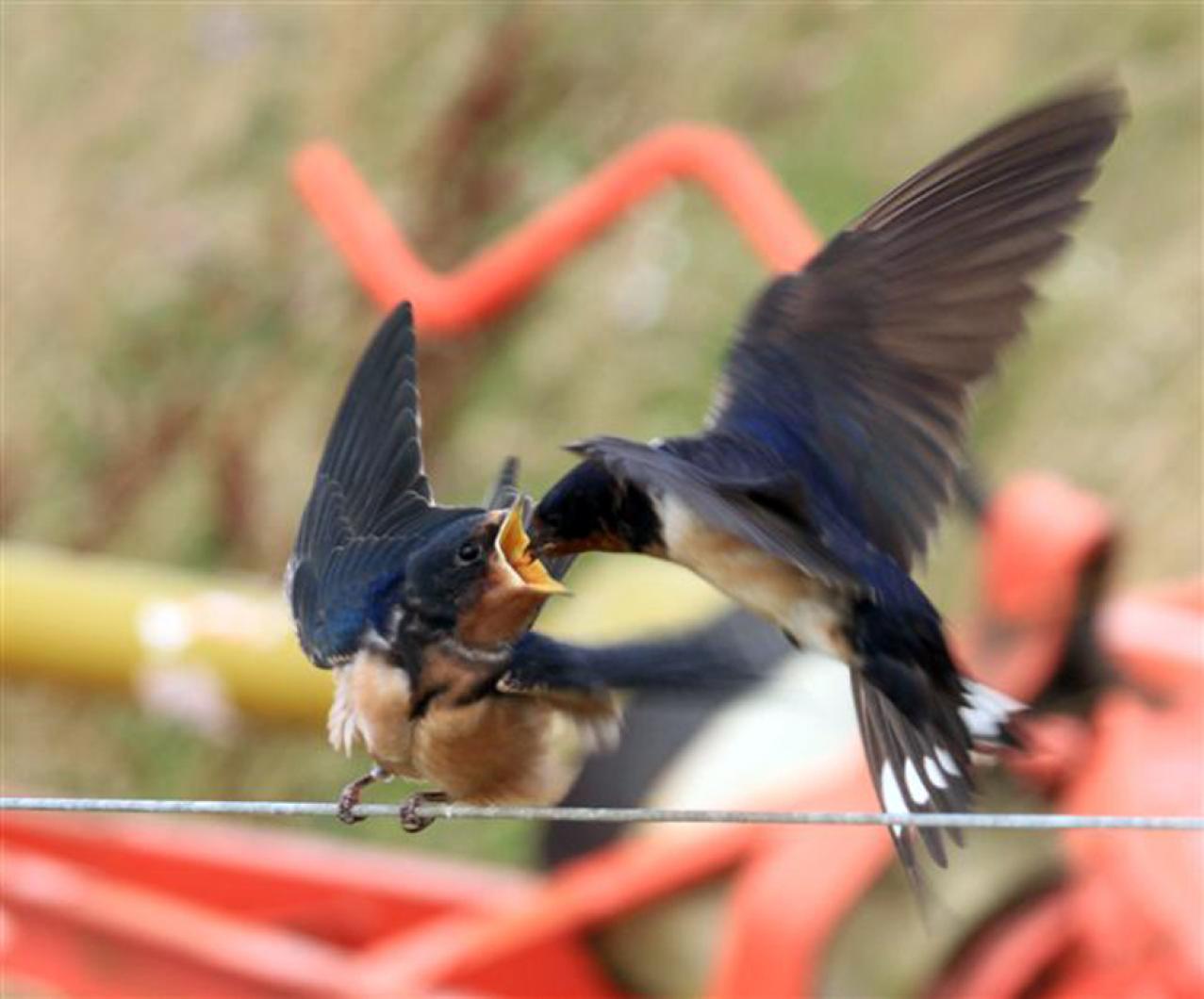What am I looking at? It appears to be a punk-rock bird star. What I see first is a stiff gray crest, gray belly and a black bill. Then as the bird turns I see the remainder of the back feathers is gray as well. It is only when I spot a slight reddishness in the outer tail feathers that I realized the bird in question is an immature northern cardinal. What a difference from the all-red adult which has a red bill surrounded by black feathers.
How about the creature in the bird bath? It has a white chest which is covered with black spots. A strong white eye ring stands out so must be an important field mark. The upper part of this bird’s wings are gray with white dots but, bingo, the lower wings are blue. Perhaps this immature eastern bluebird is taking its first bath. Again, what a shock when one is used to the adult which is a lovely blue headed and backed bird with a clear rusty breast and no eye ring.
Sitting on the fence is a bird which appears, at first glance, to be a barn swallow. Yet, there is something wrong. The spot between the eyes is white, not rust. The same is true for the chin, it’s white instead of rust. And the tail seems to be too short. Suddenly another bird flies in and the bird on the fence starts chirping away and opens its mouth wide and is promptly fed by the arriving bird. Then the new bird sits down next to the odd looking swallow. What a great comparison, adult and young barn swallow side by side. One couldn’t ask for a better opportunity to learn the difference. The adult has a dark blue back and head and a dark rust chin and forehead. Its belly is light rust and its tail much longer than the immature bird next to him. The adult female can be confusing as she has a white belly but has a dark orange forehead and chin and long tail.
Out on the beach there is an American oystercatcher which has brown eyes. Its orange bill looks as though it dipped the end into an inkwell; it is black. Again, an immature that is different from the adult who boasts orange eye rings around yellow eyes and an all red bill.
No wonder the early ornithologists suggested there were many more species than we actually have. They considered many immatures and females as separate species, and it wasn’t until research on nesting birds was conducted that the species list was reduced to its proper size. So if you see a bird that looks vaguely familiar, check a field guide and look at the image of the immature or even the female. Chances are you will find the bird in a plumage befitting a youngster or female.
Bird Sightings
On July 12, Luanne Johnson and Margaret Curtin heard a couple of Virginia rails at Sheriff’s Meadow Pond in Edgartown and also spotted chimney swifts. Warren Woessner, Lanny McDowell and I tried to find the rails later in the day to no avail. We did however see the chimney swifts.
Allan Keith heard a fish crow along the waterfront near Gannon and Benjamin’s Shipyard on July 13. The same day Margaret Curtin and Tim Simmons spotted the immature bald eagle that has been seen several places on the Island and also watched a male American kestrel hunting the Squibnocket fields.
Peter Enrich birded Tea Lane on July 14 and had a good selection of the usual suspects but also a scarlet tanager.
On July 15 Sarah Mayhew photographed a juvenile piping plover at Quansoo. Bob Woodruff reports that there are four fledged young barn owls in his barn and thinks there may be more!
Tara Whiting spotted an American kestrel being chased by a barn swallow at Whiting Farm in West Tisbury on July 16. It was this same day that an immature northern cardinal visited Dan Waters at his Indian Hill feeder. Warren Woessner and I birded Quansoo and counted 100 short-billed dowitchers, 10 sanderlings some of which were quite dark and still in breeding plumage, six immature piping plovers, six black-bellied plovers, good numbers of semipalmated plovers and sandpipers, 25 least terns and eight common terns including two immature, one roseate tern and an osprey. Later in the day Flip Harrington and I counted 12 American oystercatchers and three killdeer on Big Sandy in Tisbury Great Pond.
Warren Woessner birded Norton Point on July 17 and spotted short-billed dowitchers, least sandpipers, American oystercatchers, 11 willets and one whimbrel.
On July 18, Luanne Johnson found that a single mom piping plover who lost her mate a few days before hatching has successfully incubated the nest and hatched three chicks. Several Island birders are taking turns watching the chicks to protect them from possible predation by crows or other critters. So far of the piping plover nests that Luanne has been monitoring this season, there have been eleven piping plovers chicks fledged and there are still four nests that are being incubated. It appears that least tern colonies at Little Beach, Quansoo and Norton Point are building after their demise at a sandbar off Tuckernuck. It is a late season and one hopes the young will be fledged and south before the snow flies.
Susan B. Whiting is the coauthor of Vineyard Birds and Vineyard Birds II. Her Web site is vineyardbirds2.com.
Please report your bird sightings to the Martha’s Vineyard Bird Hotline at 508-645-2913 or e-mail to birds@mvgazette.com.




Comments
Comment policy »